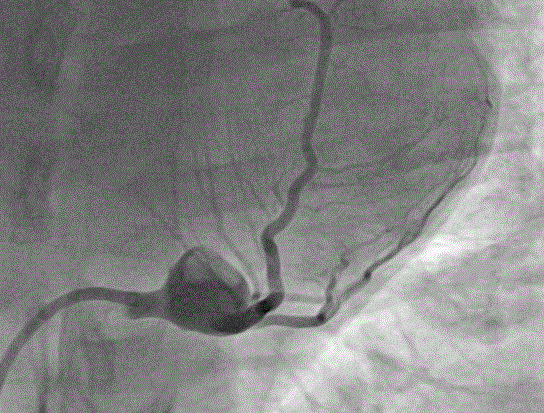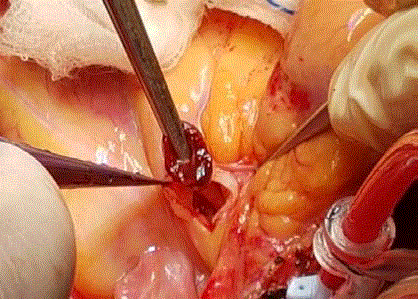Clinical Image
Congenital or Acquired
Ali Kindawi1, Fahad Al Kindi2 and Cornelia S Carr1*
1Department of Cardiac Surgery, Heart Hospital, Qatar
2Department of Cardiology, Heart Hospital, Qatar
*Corresponding author: Cornelia S Carr, Department of Cardiac Surgery, Heart Hospital, Doha, Qatar
Published: 01 Dec, 2017
Cite this article as: Kindawi A, Al Kindi F, Carr CS.
Congenital or Acquired. Clin Surg.
2017; 2: 1797.
Keywords
Coronary artery aneurysm; Congenital; Acquired
Clinical Image
A 22 year old man presented with chest pain, and electrocardiogram showed ST elevation inferiorly. He denied childhood illnesses, trauma and atherosclerotic risk factors. Following thrombolysis, he had persistent pain so underwent coronary angiography (Figure 1). With on-going ischemia he underwent emergency surgery (Figure 2). The aneurysm was incised, (clot extracted, Figure 2) and plicated, and bypass grafts were performed. The patient was extubated 48 hr later and made a good recovery. Coronary artery aneurysm: a localized coronary dilatation >1.5 times the diameter of the adjacent segment [1], with aetiologies such as atherosclerosis, Kawasaki’s disease [1,2] or percutaneous interventions [3]. Kawasaki Disease (KD) results from a disordered inflammatory response and is a multisystem vasculitis [2] with patients usually having coronary stenosis and occlusion, calcification and aneurysm formation in the same coronary vasculature [2]. Large coronary artery aneurysms (any etiology) may require resection and possible coronary artery bypass grafting [1,4].
Figure 1
Figure 2
References
- Chiusaroli A, Segreto A, De Salvatore S, Congiu S, Zicho D, Bizzarri F. Coronary artery aneurysms: case report and treatment overview. Eur Rev Med Pharmacol Sci. 2015;19(14):2572-4.
- Friedman KG, Gauvreau K, Hamaoka-Okamoto A, Tang A, Berry E, Tremoulet AH, et al. Coronary artery aneurysms in Kawasaki disease: risk factors for progressive disease and adverse cardiac events in the US population. J Am Heart Assoc. 2016;5(9):e003289.
- Solomonica A, Musallam A, Roguin A. Coronary artery aneurysm following drug-coated balloon treatment. Cardiovasc Revasc Med. 2015;16(8):505-7.
- Sherif SA, Taşköylü O, Goktekin O, Kilic ID. Coronary artery aneurysms: a review of the epidemiology, pathophysiology, diagnosis, and treatment. ront Cardiovasc Med. 2017;5(4):24.


